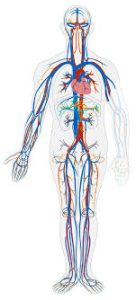 Regulated to supply blood to tissues and to increase or decreases heat loss from the body by redistribution blood supply, and maintains blood supply to heart and brain in the presence of hemorrhage.
Regulated to supply blood to tissues and to increase or decreases heat loss from the body by redistribution blood supply, and maintains blood supply to heart and brain in the presence of hemorrhage.
Adjustments in the system includes altering the output of the heart, changes to the resistance of blood vessels or altering the amount of blood pooled in the capacitance of the venous system.
Arteriole caliber is adjusted partly by autoregulation.
Caliber of arterioles is increased in tissues by endothelial secretions and is regulated as well by circulating vocative substances and vasomotor nerves.
The venous capacitance is affected by circulating vocative substances and by vasomotor nerves.
Local and systemic regulation occurs throughout the body to adjust vascular responses.
Vasoconstriction refers to constriction of resistance of vessels.
Vasodilation refers to dilation of resistance vessels.
Venoconstriction refers to the changes in the caliber of veins.
Autoregulation refers to tissue regulation of its own blood flow.
Most vascular beds have an intrinsic capacity to adapt to changes in perfusion pressure by changes in vascular resistance, so blood floe remains constant.
Autoregulation is prominent in kidneys, skeletal muscles, brain, liver, and heart muscle.
Autonregulation, in part, is due to the intrinsic contractile response of smooth muscle to stretch-the myogenic theory of autoregulation.
Vasodilation refers to the changes in the caliber of veins.
